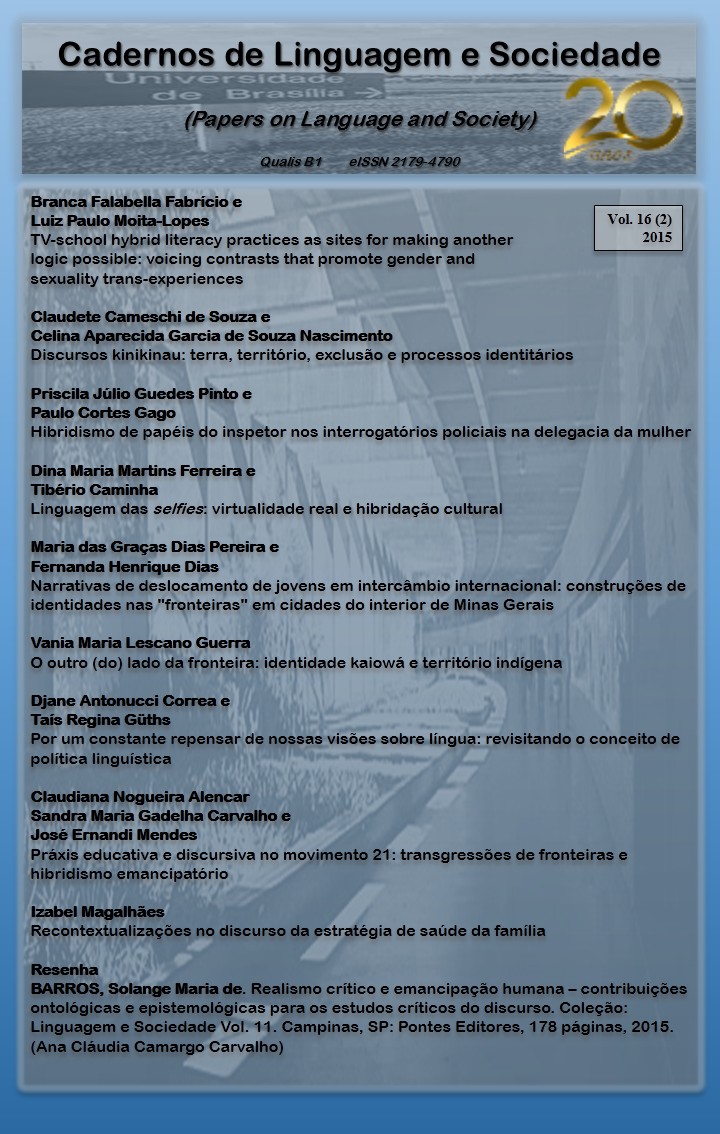TV-school hybrid literacy practices as sites for making another logic possible: voicing contrasts that promote gender and sexuality trans-experiences
DOI:
https://doi.org/10.26512/les.v16i2.7476Keywords:
hybrid literacy practices, voicing contrast, trans-experiences, gender and sexualityAbstract
Considering the relationship between media and sense-making in Brazil, the purpose of this article is to examine an interventionist collaborative ethnography in a specific literacy context ”“ history classes in a Brazilian state school, in which the classroom teacher, two researchers, and 5th grade students conjointly try to decenter commonsense views of gender and sexuality. By making ample recourse to media texts and to radical hybridity, they work towards promoting classroom literacy practices which “de-ground” certainties by shaking them through border-crossing (Mignolo 2000) and triggering the negotiation of new perspectives for social life. By dramatizing cemented social voices and engaging in what we have termed trans-experiences, participants show that social matrices and solidified meanings do not simply impose themselves on individuals but live through microsociological encounters. This movement is made visible through a microanalytical approach that, capturing tenuous voicing contrasts indexed by register use, reveals a delicate, but significant, performative flux.
Downloads
References
APPADURAI, A. (1996). Modernity at large: cultural dimensions of globalization. Minneapolis: University of Minnesota Press.
BAKHTIN, M. M. (1981). The dialogic imagination: four essays. Michael Holquist (Ed.). Austin: The University of Texas Press.
BRAH, A.; COOMBES, A. E. (Eds.) (2000). Hybridity and its discontents: politics, science and culture. London: Routledge.
BUCCI, E. (2004). Ainda sob o signo da Globo. In: Bucci, E.; Kehl, M. R. Videologias. São Paulo: Boitempo, pp. 220-240.
_____; KEHL, M. R. (2004). Videologias. São Paulo: Boitempo.
BUTLER, J. (2004). Undoing gender. New York: Routledge.
_____ (1994). Gender as performance: an interview with Judith Butler. Interview by Peter Osborne and Lynne Segal. London, 1993. Radical Philosophy, 67: 32-39.
_____ (1990). Gender trouble: feminism and the subversion of identity. New York: Routledge.
CANCLINI, N. (1987/2000). Culturas híbridas. Estratégias para entrar e sair da modernidade. Trans. Heloísa P. Cintrão. São Paulo: Editora da Universidade de São Paulo.
_____ (n/d). La globalización? Productora de culturas híbridas? Mimeo.
COPE, B.; KALANTZIS, M. (2000a). Multiliteracies: literacy learning and the design of social futures. London: Routledge.
COPE, B.; KALANTZIS, M. (2000b). Designs for social futures. In Cope, B.; Kalantzis, M. Multiliteracies: literacy learning and the design of social futures. London: Routledge, pp. 203- 234.
COUPLAND, N.; GARRETT, P.; WILLIAMS, A. (2005). Narrative demands, cultural performance and evaluation: teenage boys’ stories for their age peers. In Thornborrow, J.; Coates, Jennifer (Eds.) The sociolinguistics of narrative. Amsterdam: John Benjamins, pp. 67-88.
EGAN-ROBERTSON, A.; BLOOME, D. (Eds.) (1998). Students as researchers of culture and language in their own communities. New Jersey: Hampton Press.
FABRÍCIO, B. F (2012). Trajectories of socialization in school transcontexts: discourse journeys on gender and sexuality, Working Papers in Urban Language & Literacies 94, 2012, available at www.kcl.ac.uk/ldc.
_____; MOITA-LOPES, L. P. (2010). A dinâmica dos (re)posicionamentos de sexualidade e práticas de letramento escolar: entre oscilações e desestabilizações sutis. In Moita Lopes, L. P.; Bastos, L. C. (Eds.) Para além da identidade: fluxos, movimento e trânsitos. Belo Horizonte: Ed. UFMG, pp. 283- 314.
GEE, J. P. (1994). Orality and literacy: from The Savage Mind to Ways with Words. In Maybin, J. (Ed.) Language and literacy in social practice. Clevedon: Multilingaul Matters, pp. 168-192.
GOFFMAN, E. (1974). Frame analysis. Cambridge, MA: Harvard University Press.
_____. (1981). Footing. Forms of talk. Philadelphia: University of Pennsylvania Press.
GRUZINSKI, S. (1999). O pensamento mestiço. Trans. Rosa Freire d’Aguiar. São Paulo: Companhia das Letras.
JAGOSE, A. (1996). Queer theory. An introduction. New York: New York University Press.
KRESS, G. (2003). Literacy in the new media age. London: Routledge.
MARTÍN-BARBERO, J. (2001). Dos meios à s mediações. Comunicação, cultura e hegemonia. Trans. Ronald Polit; Sérgio Alcides. Rio de Janeiro: Editora UFRJ.
MAYBIN, J.; MOSS, G. (1993). Talk about texts: reading as a social event. Journal of Research in Reading 16 (2), 138-137.
MIGNOLO, W. D. (2000) Local histories / Global designs. Coloniality, subaltern knowledges and border thinking. Princeton: Princeton University Press.
MOITA-LOPES, L. P. (2006/2011). Por uma linguística aplicada indisciplinar. São Paulo: Parábola.
_____ (2010). Os novos letramentos digitais como lugares de construção de ativismo político sobre sexualidade e gênero. Trabalhos de Linguística Aplicada, 49 (2), 393-417.
_____ (2005). A construção do gênero e do letramento na escola: como um tipo de conhecimento gera o outro. Investigações Linguísticas e Literárias, 17, 47-68.
PENNYCOOK, A. (2007). Global Englishes and transcultural flows. London: Routledge.
_____ (2010). Language as a local Practice. London: Routledge.
ROBERTSON, R. (1995). Glocalization: time-space and homogeneity-heterogeneity. In: M. Featherstone, M.; Lash, S. and Robertson, Roland. (Eds.) Global Modernities. London: Sage.
SARLO, B. (2000). Cenas da vida pós-moderna. Intelectuais, arte e videocultura na Argentina. Trans. Sérgio Alcides. Rio de Janeiro: Editora UFRJ.
SULLIVAN, N. (2003). A critical introduction to queer theory. New York: New York University Press.
TRAVANCAS, I. (2007). Juventude e televisão. Rio de Janeiro: Editora FGV.
THOMAS, Ni. (2000). Technologies of conversion: cloth and Christianity in Polynesia. In BRAH, A.; COOMBES, Anne E. (Eds.) Hybridity and its discontents: politics, science and culture. London: Routledge, pp. 198-215.
VENN, C. (2000). Occidentalism. Modernity and Subjectivity. London: Sage.



